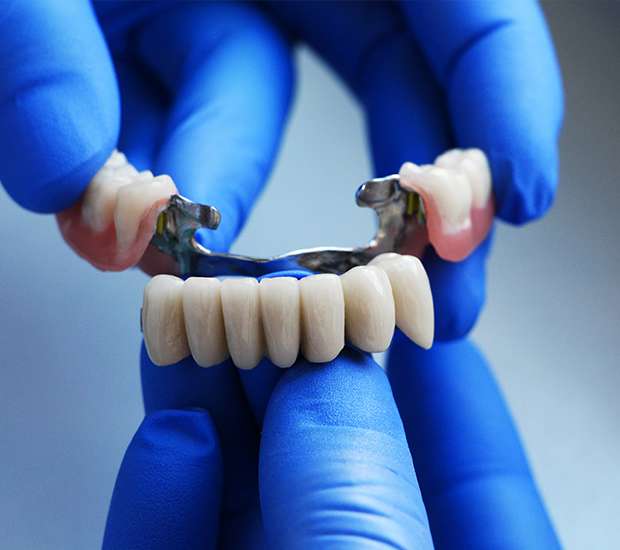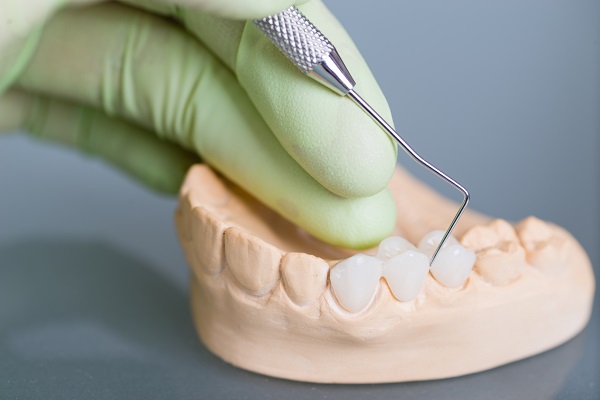Dental Bridges Miami, FL
If you are missing some of your teeth, we can replace them using a dental bridge. This is a secure and permanent alternative to wearing dentures. We can work to make a dental bridge look entirely natural after we place it on your teeth. We begin the procedure by taking precise measurements of your teeth in our dentist office. We will also take an impression, so the dental lab has all the information they need to create replacement teeth that look like your natural ones. To find out if you are a good candidate for the procedure, call (305) 858-0505 and schedule a consultation. At Dr. Rita The Smile Designer, we offer several solutions for replacing missing teeth, so if a bridge is not suited to your needs, we will recommend a different solution.
What is a dental bridge?
A bridge is a fixed prosthetic that can be an effective solution in cases of partial tooth loss. It is exactly as the name suggests, a bridge that replaces lost teeth between your remaining strong ones. However, in order to qualify for a dental bridge, you must have remaining teeth that are strong enough to support it. If you do, we will place dental crowns on those teeth these teeth so they can serve as anchors to hold up a gum-colored base that we can use to secure the bridge. Essentially, your remaining teeth provide the support necessary for ensuring your new tooth or teeth stay in place.
Why should I get a dental bridge?
There are several reasons to get a dental bridge, including restoring the appearance of your smile; giving you the ability to eat and speak normally; preserving the shape and structure of your face; and preventing pressure and wear on your remaining teeth.
How does a dental bridge compare to standard dentures?
When you visit our dental office, we can discuss what the differences will be like from the perspective of the treatment and process. Generally speaking, the most significant difference between a dental bridge and dentures is that dentures are removable. Since they need to come out nightly, you will not have a full set of teeth 24/7. Simultaneously, anything removable runs the risk of becoming loose or even falling out at inconvenient times. For this reason, patients may be uncomfortable wearing dentures and prefer a more secure solution. If you are wearing dentures currently and find that you have difficulty eating your favorite foods, laughing loudly, or playing sports when wearing them, consider this alternative.
Check out what others are saying about our dental bridge services on Yelp: Dental Bridges Miami
Will my dental bridge look natural?
Absolutely. At Dr. Rita The Smile Designer, we will take every step necessary to ensure they look natural and fit perfectly. We begin by taking accurate measurements and also matching the shade of your prosthetic with your surrounding natural teeth. If your other teeth are stained or yellow, now is an excellent time to whiten them since we will create your new teeth using materials that are both resistant to stain and bleach.
How long does a dental bridge last?
The duration of a dental bridge is different for everyone and is impacted by your daily habits. However, fixed dental bridges can last for 15 years or even longer. On the short end, they tend to last for five years. One thing to keep in mind is that the overall health of your mouth will influence the longevity of your bridge. Since the natural teeth with dental crowns determine the stability of the bridge, you must keep your natural teeth healthy. We recommend you do so by visiting our Miami, FL dental office for a teeth cleaning and dental examination twice a year. We can remove built-up plaque to prevent decay and infections. If you develop any oral health problems, we will address them immediately. We will prevent the problems from spreading do not spread and your mouth can remain in excellent health.
What can I expect from the procedure?
When you visit our dentist office for a dental bridge, we will begin by conducting an examination and taking X-rays. We need to determine whether your remaining teeth are strong enough to support a bridge. We also need to make sure you do not have any decay or infections. If you do, we will treat the problem before placing your bridge. Afterward, we will prepare your abutment teeth for the placing of dental crowns. We remove a small portion of the enamel from around the teeth. Next, we will take measurements, make an impression, and use a shade card to determine what shade your new teeth need to be. This information will all be sent to the dental lab to create your new crowns and bridge. In the meantime, we will place a temporary bridge in your mouth. This will not look as good or be as secure as the final product, but it will preserve your appearance while you wait.
Once your new bridge is ready, you will need to come back to our Miami, FL dentist office so we can remove the temporary bridge and bond the new one in place in place. We may need to make some minor adjustments during the fitting process and will do what is necessary to ensure that it fits correctly, is comfortable, and looks natural. Taking the time to do so will help you to enjoy your new teeth now and in the future.
Will getting a dental bridge be uncomfortable?
At Dr. Rita The Smile Designer, we can provide you with anesthesia to help you remain comfortable while getting your new dental bridge. The only time anesthesia may be necessary is when we are preparing your teeth or when we are securing your bridge in place. Feel free to let us know how you are feeling about the procedure and will help you to relax.
To learn more about dental bridges and how they can be used to replace your missing teeth, call 3058580505. Our Miami, FL dental office is conveniently located, and we are currently accepting new patients.
Questions Answered on This Page
Q. Will a dental bridge look natural?
Q. How long will a dental bridge last?
People Also Ask
Q. Which tooth replacement is right for me?
Q. Can dental bridges replace my missing teeth and restore my smile?
Definition of Dental Terminology
- Cosmetic Dentistry
- Cosmetic dentistry combines comprehensive dental principles with artistic sensibility to design and create optimally healthy and beautiful restorations intended to enhance the appearance of one’s smile while preserving ideal function and form.
- Decay
- Tooth decay is when the enamel of the tooth begins to breakdown as a result of bacterial invasion, causing an acidic induced erosion of healthy tooth structure.
- Dental Caries
- Dental caries are also known as cavities and can result from a lack of proper oral hygiene. A synonym of “decay”, and also called “cavities”, caries is a breakdown of teeth due to acids made by bacteria. The cavities may be a number of different colors from yellow to black.
- Dental Checkup
- A comprehensive oral examination that focuses on the evaluation of hard and soft oral structures including, but not limited to, the teeth, gums, jaw bone, jaw joint, bite, and cosmetic aspects of the smile. Both clinical and radiographic information is used to assess the status of the oral health while detecting any form of pathology that may affect the health of the oral cavity and its associated structures.
- Dental Filling
- A dental filling involves restoring the damaged structure of a tooth by using tooth colored resins or porcelain materials to restore natural form, function, and estethetics to the dentition.
- Dental Prophylaxis
- A dental prophylaxis is a professional and detailed cleaning that involves the removal of plaque, calculus and stains from the teeth,thereby reducing the risks of inflammation and breakdown of the dentition’s supporting structures.
- Dental Sealants
- Dental sealants are preventative restorations that contain a resinous material that is applied to the deep pits and fissures detected on the chewing surfaces of newly erupted teeth. These are used to help prevent dental caries from developing in children’s permanent molars and premolars.
- Dentist
- A dentist, also known as a dental surgeon, is a doctor who specializes in the diagnosis, prevention, and treatment of diseases and conditions of the oral cavity.
- Gingivitis
- Gingivitis is the inflammation of gum tissue that results from plaque, other infections in the mouth, and poor oral hygiene. Gingivitis can be a precursor to more advanced forms of periodontal disease if it is not controlled and reversed. Signs of gingivitis include soft tissue redness,inflammation, and bleeding. Proper brushing, flossing, and prevention helps to prevent and reverse signs of early gum disease.
- Preventive Dentistry
- Preventive dentistry focuses on education, modalities, and treatment designed to achieve and maintain optimal oral health, described as one free of structural, bacterial, and restorative breakdown.
- Tartar
- Tartar forms when plaque builds up on the surface of the teeth and calcifies into a hard surface that is much more difficult to remove. Its presence will require professional dental debridement and education on its prevention. Daily removal of plaque by proper brushing and flossing habits will reduce the incidence of tartar and the pathology associated with its presence.
- Tooth Enamel
- Tooth enamel is the outermost protective layer of the tooth. Enamel is white and visible. Its hard composition protects the underlying layers, dentin and pulp, respectively.
Back to top of Dental Bridges




